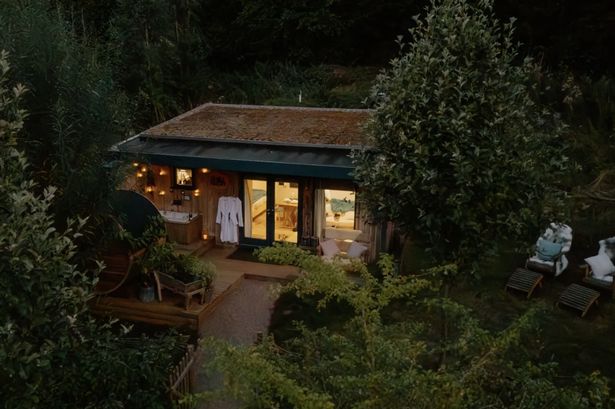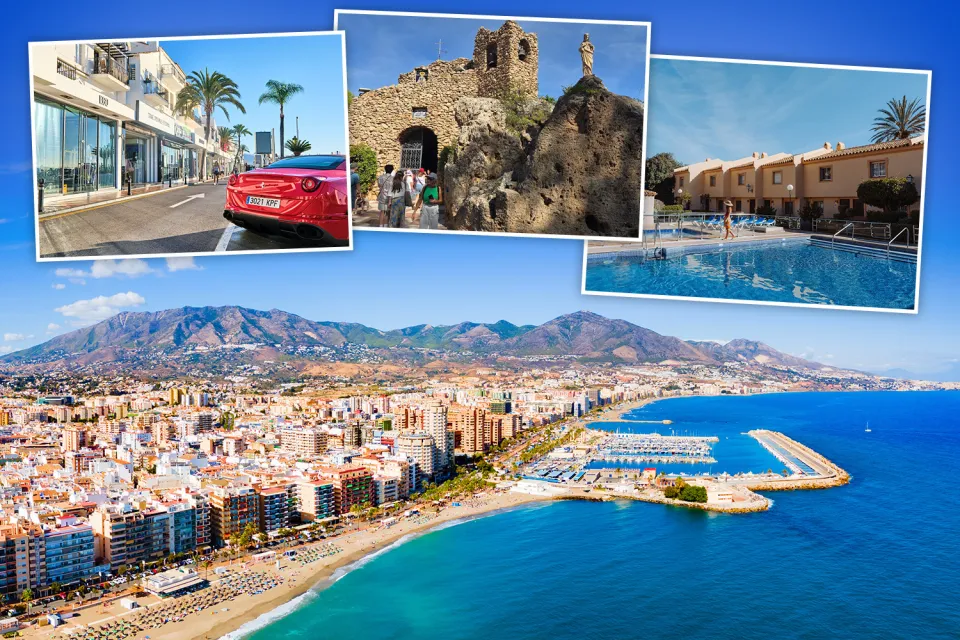Dog-friendly forest cabin with sauna and outdoor bath is perfect for Autumn staycation
Many Brits are now looking for a comfortable staycation to take this autumn. The main challenge that many dog owners face when arranging a holiday is considering who will care for their pe. But they needn’t fret any longer if they’re reserving one luxurious collection of cabins
Plenty of people are currently searching for the ideal spot to enjoy an autumn getaway. The bright summer holidays are behind us and numerous
Brits are now choosing to book a comfortable staycation within the UK instead. The main challenge that many dog owners face when arranging a holiday is considering who will care for their pet. But they needn’t fret any longer if they’re reserving one luxurious collection of cabins situated in The Forest of Dean in Gloucestershire, which is completely dog-friendly. The Roost Luxury Cabins all feature a private sauna, outdoor bathtub, log burner and fire pit. There’s also all the kitchen kit you’ll require – a kettle, toaster, induction hob, microwave, mini-oven, fridge (with small freezer) and a dishwasher.
Plus pots, pans, crockery, cutlery, cooking utensils, washing up liquid, dishcloths, tea towels, cooking condiments, fresh ground coffee plus various teas and fresh milk.
All your bed linen and extra fluffy Egyptian towels are provided too, and there will even be some homemade brownies awaiting you.
Those bringing pets are permitted two small dogs or one medium sized dog.
The venue explains: “We leave a blanket, towel, poo bags, water and food bowel and a treat for each dog.
“If you pooch has got a bit muddy on all those lovely walks, we provide doggy towels and have a dog wash area behind the site office.”
They also provide details on canine-friendly pubs and eateries nearby.
There’s a fee of £30 for one dog (£40 for two dogs) per stay. This must be paid by card to the proprietor before arrival.
Discussing their dog-welcoming approach on their website, The Roost Luxury Cabins state: “Don’t leave your best friend behind! Here at The Roost we love dogs. The cabins are dog friendly with secure garden areas and all your doggy needs are catered for.
“Your pooch will be spoilt with their own handmade truckle bed.”
The establishment shared a video on its TikTok account showcasing the cabins, which rapidly became popular, gathering over 93,000 likes.
A dog was visible outside the lodge as the footage started, before revealing the outdoor bathing facility. The snug sleeping quarters were then displayed, accompanied by glimpses of the charming garden and external sauna.
Text overlay stated: “Call me crazy, but I would choose this with the dog over a fancy hotel.”
One viewer declared: “Oh my God, this looks INSANE!”
Whilst another commented: “Omg love this! Will have to take a look.”
A third remarked: “Looks like my sort of heaven.”
Visitors planning to book should be aware the location requires a minimum 2-night booking and check-in is restricted to Monday, Wednesday or Friday.
Rates are generally £499 per two nights but may fluctuate based on the date.
Whilst the establishment welcomes dogs brilliantly, families with children might prefer alternative accommodation as the cabins are exclusively for adults. Guests can select between two distinct cabins – The Nook and The Nest, with further information available on The Roost Luxury Cabins website.
The accommodation currently boasts a 5-star rating on Tripadvisor, drawing from 112 reviews.
One guest commented: “We have had a really relaxing and enjoyable week in this amazing cabin! Loved the sauna and hot tub and sitting on the swing seat enjoying the peace! A beautiful place in a wonderful location.”
Meanwhile, another visitor remarked: “A perfect place to celebrate our 5th wedding anniversary. Everything is beautiful and the soak tub and sauna made it super relaxing. We loved explore the local area and will definitely be back.”
What attractions can be found close to the cabins?
Outdoor and nature
- Beechenhurst and the Forest of Dean Sculpture Trail: Explore art installations in a woodland setting.
- Go Ape: Enjoy high ropes courses and zip-lines in the trees.
- Forest of Dean Cycle Centre: Rent bikes for various woodland trails.
- Dean Forest Railway: Ride a steam train through the forest.
- Perrygrove Railway: A family attraction with a miniature railway and treehouses.
- May Hill: A prominent hill with a distinctive cluster of trees on top, offering great views.
- Wye Valley: Explore canoeing, kayaking, and walking opportunities along the river.
History and heritage
- Hopewell Colliery: Take an underground tour of this working free mine.
- Clearwell Caves: Explore this ancient and unique underground attraction.
- Dean Heritage Centre: Learn about the local history of the Forest of Dean.
- Soldiers of Gloucestershire Museum: Discover the history of the regiment in Gloucester.
- Museum of Gloucester: Explore thousands of exhibits on the city’s past.
- Jet Age Museum: See aircraft and aviation equipment in Gloucester.
- National Waterways Museum: Learn about waterways in Gloucester.
- Coleford Great Western Railway Museum: A museum dedicated to the railway.
Other attractions
- Gloucester Cathedral: A magnificent cathedral in Gloucester with famous cloisters.
- Nature in Art: Explore art exhibitions and a sculpture garden.
- Sudeley Castle and Gardens: Visit this historic castle and its extensive gardens.
Buchanan Decries Illegal Immigration : Politics: The GOP candidate calls the influx an invasion and says it causes social, economic and drug problems.
SAN DIEGO — As a bemused crowd of would-be illegal immigrants looked on from a makeshift hilltop refreshment stand, Republican presidential candidate Patrick J. Buchanan on Tuesday stepped into a confrontational arena that sums up his often confrontational campaign: the U.S.-Mexico border.
“I am calling attention to a national disgrace,” Buchanan told reporters, his suit and shoes dusty from a Border Patrol tour of the rugged terrain. “The failure of the national government of the United States to protect the borders of the United States from an illegal invasion that involves at least a million aliens a year. As a consequence of that, we have social problems and economic problems. And drug problems.”
Saying that up to 1,000 illegal immigrants were among those arrested during the Los Angeles riots, Buchanan repeated his previous calls to fortify key sections of the border with ditches and concrete-buttressed fences and to deploy U.S. military forces there if necessary.
Buchanan also advocated doubling the size of the Border Patrol to 6,600 agents, staffing immigration checkpoints on Interstates 5 and 15 24 hours a day and charging a $2 toll on legal crossings to pay for tougher enforcement.
“I don’t believe in being brutal on anyone,” he said. “But I do think that any country that wants to call itself a nation has got to defend its borders.”
Illegal immigration lies at the heart of Buchanan’s vision of what is wrong with America; the issue is perhaps the strongest attention-getter in Southern California for his fading GOP challenge.
Buchanan’s first visit to the San Diego-Tijuana border made for strange media theater. The candidate arrived by four-wheel-drive vehicle to a hot, dusty ridge overlooking Smuggler’s Canyon, a prime crossing area, where a new corrugated steel barrier meets an old, battered chain-link fence. Buchanan supporters in suits and ties reached across the international line to buy soft drinks at a makeshift refreshment stand.
About 25 Mexican migrants, most of whom had heard only vaguely of Buchanan, chatted with security agents and tried to make sense of the pin-striped visitor.
“He’s a presidential candidate?” asked a man named Guillermo. “Does he speak Spanish? Ask him if he can pull the migra out of here for 24 hours, then he can do whatever he wants. Ask him if he can give me a ride to Los Angeles.”
Filoberto, a wiry 23-year-old from Mexicali, scoffed when informed that Buchanan advocates sealing the border and giving the Border Patrol more agents and equipment.
“They have all kinds of technology,” said Filoberto, who was waiting to make his fourth attempt at crossing in a week. “But we are smarter; people are smarter than machines. We are still going to cross. In fact, as soon as all of you people get out of here, we are going to go for it.”
To the discomfort of Buchanan aides, neo-Nazi Tom Metzger showed up with a handful of raucous supporters.
Metzger’s group hovered at the edges of the press conference, yelling insults about illegal immigrants, Republicans and Democrats.
Metzger, a former leader of the Ku Klux Klan and the White Aryan Resistance, was recently convicted of unlawful assembly in a Los Angeles cross-burning. He was sentenced to six months in jail but released after 46 days because of his wife’s illness and subsequent death. He said he wanted to talk to Buchanan about getting “action” to control the border.
But Buchanan rejected Metzger, saying that if Metzger contributed money to his campaign it would be returned. “I don’t have anything to do with him,” he said.
Buchanan said he thinks that he can influence President Bush’s policy–despite the fact that Bush has the GOP nomination locked up. “I think we are going to get George Bush to do something about this before that election, or at least speak to this,” he said. “He’d better do it, or he’s going to have problems.”
Some Día de los Muertos festivies are canceled, others march forward
In Mexico and parts of Central America, Día de los Muertos is regarded as a day to commemorate and celebrate departed family and friends.
For generations, Greater Southern California has joined the tradition with altars, Aztec dances and displays of marigolds in late October to early November. The day to honor the dead also has served as a day of gathering among the living.
However, some celebrations are being reconsidered because of fears that participants may get caught in deportation raids executed by U.S. Immigration and Customs Enforcement agents.
This week the Department of Homeland Security announced it had deported more than half a million undocumented people since the Trump Administration took over in January. More than 2 million people have left the nation overall, the department said.
With raids continuing, some organizers of this weekend’s Día de los Muertos events are moving ahead with celebrations, while others have canceled them.
Times reporters spoke with event organizers to learn what they’re doing differently.
Cancellation is the policy
My colleague Suhauna Hussain reported in mid-September that Long Beach was nixing its annual parade, which drew sizable crowds in the past.
The event was canceled at the request of City Councilmember Mary Zendejas “out of an abundance of caution,” according to city spokesperson Kevin Lee, because it’s “a large and very public outdoor event.” Officials were not aware of any targeted federal enforcement activity.
“This decision did not come lightly,” Zendejas and the city said in statements. The decision addresses “genuine fears raised by community members, especially those who may face the possibility of sudden and indiscriminate federal enforcement actions that undermine the sense of security necessary to participate fully in public life.”
Roberto Carlos Lemus, a marketer who brought food trucks and other vendors to the festival last year, called the cancellation “very sad.”
“Everyone’s very sad about the situation. Día de los Muertos has been one of the largest celebrations for a very long time, and the city has done a great job putting it on,” Lemus told The Times. “Unfortunately, with Latinos being kidnapped and attacked by ICE and the current administration, I do understand why they made the decision that they made.”
The action was mirrored in other places. Santa Barbara’s Museum of Contemporary Art canceled its own parade because the “threat to undocumented families remains very real.” In Northern California, organizations in Berkeley and Eureka also canceled celebrations for similar reasons.
Moving ahead
Others are not letting the immigration raids interfere with the celebration.
Last year, tens of thousands of visitors patronized Division 9 Gallery’s Day of the Dead celebration in downtown Riverside. This year’s free two-day event will feature Aztec dancers, a pageant, processions, Lucha Libre wrestlers and altars — the traditional stands along with ofrendras placed inside classic cars — on Saturday and Sunday.
The event, located on Market Street between University Avenue and 14th Street, continues to grow in popularity, organizer Cosmé Cordova said.
Cordova said he’s not sure if there will be 60 altars, as was the case last year, or if 45,000 people will attend Saturday, the most popular of the two days.
“Because of what’s going on, people are afraid,” he said. “But we’re not canceling.”
Cordova said he’s hired security and noted that Riverside police and the mayor will be present.
“We’re working with the city and others to make sure everything is going to be good,” Cordova said. “This is an event that the community comes out for and I’m not concerned about anyone breaking it up.”
The week’s biggest stories
Gladstone’s Malibu, an iconic dining landmark, pictured partially smoking from the Palisades Fire on Jan. 8, 2025.
(Connor Sheets/Los Angeles Times)
Palisades Fire investigation
Dodgers World Series coverage
Trump Administration polices and reactions
Crime, courts and policing
More big stories
This week’s must-read
More great reads
For your weekend
Going out
Staying in
Have a great weekend, from the Essential California team
Jim Rainey, staff writer
Kevinisha Walker, multiplatform editor
Andrew J. Campa, reporter
Hugo Martín, assistant editor
Karim Doumar, head of newsletters
How can we make this newsletter more useful? Send comments to [email protected]. Check our top stories, topics and the latest articles on latimes.com.
Rebuilding Gaza begins in the classroom | Israel-Palestine conflict
It has been two weeks since world leaders gathered in Sharm el-Sheikh and declared, once again, that the path to peace in the Middle East had been found. As with previous such declarations, the Palestinians, the people who must live that peace, were left out.
Today, Israel holds the fragile ceasefire hostage while the world is fixated on the search for the remaining bodies of its dead captives. There is no talk of the Palestinian right to search for and honour their own dead, to mourn publicly the loss.
The idea of reconstruction is dangled before the residents of Gaza. Those who call for it from abroad seem to envision just clearing rubble, pouring concrete, and rehabilitating infrastructure. There is no talk of rebuilding people – restoring their institutions, dignity, and sense of belonging.
But this is what Palestinians need. True reconstruction must focus on the people of Gaza and it must begin not with cement but with the restoration of classrooms and learning. It must begin with young people who have survived the unthinkable and still dare to dream. Without them – without Palestinian educators and students at the centre – no rebuilding effort can endure.
Reconstruction without exclusion
The plans for governance and reconstruction of Gaza currently circulating are excluding those Palestinians most affected by the genocide. Many aspects of these plans are designed to control rather than empower – to install new overseers instead of nurturing local leadership. They prioritise Israel’s security over Palestinian wellbeing and self-determination.
We have seen what such exclusion leads to in the Palestinian context: dependency, frustration and despair. As scholars who have worked for years alongside Palestinian academics and students, we have also seen the central role education plays in Palestinian society.
That is why we believe that reconstruction has to start with education, including higher education. And that process has to include and be led by the Palestinians themselves. Palestinian educators, academics and students have already demonstrated they have the strength to persevere and rebuild.
Gaza’s universities, for example, have been models of resilience. Even as their campuses were razed to the ground, professors and scholars continued to teach and research in makeshift shelters, tents, and public squares – sustaining international partnerships and giving purpose to the most vital part of society: young people.
In Gaza, universities are not only places of study; they are sanctuaries of thought, compassion, solidarity and continuity – the fragile infrastructure of imagination.
Without them, who will train the doctors, nurses, teachers, architects, lawyers, and engineers that Gaza needs? Who will provide safe spaces for dialogue, reflection, and decision-making – the foundations of any functioning society?
We know that there can be no viable future for Palestinians without strong educational and cultural institutions that rebuild confidence, restore dignity and sustain hope.
Solidarity, not paternalism
Over the past two years, something remarkable has happened. University campuses across the world – from the United States to South Africa, from Europe to Latin America – have become sites of moral awakening. Students and professors have stood together against the genocide in Gaza, demanding an end to the war and calling for justice and accountability. Their sit-ins, vigils and encampments have reminded us that universities are not only places of learning but crucibles of conscience.
This global uprising within education was not merely symbolic; it was a reassertion of what scholarship is about. When students risk disciplinary action to defend life and dignity, they remind us that knowledge divorced from humanity is meaningless.
The solidarity they have demonstrated must set the tone for how institutions of higher education approach engagement with and the rebuilding of Gaza’s universities.
The world’s universities must listen, collaborate and commit for the long term. They can build partnerships with Gaza’s institutions, share expertise, support research and help reconstruct the intellectual infrastructure of a society. Fellowships, joint projects, remote teaching and open digital resources are small steps that can make a vast difference.
Initiatives like those of Friends of Palestinian Universities (formally Fobzu), the University of Glasgow and HBKU’s summits, and the Qatar Foundation’s Education Above All already show what sustained cooperation can achieve. Now that spirit of solidarity must expand – grounded in respect and dignity and guided by Palestinian leaders.
The global academic community has a moral duty to stand with Gaza, but solidarity must not slide into paternalism. Reconstruction should not be a charitable gesture; it should be an act of justice.
The Palestinian higher education sector does not need a Western blueprint or a consultant’s template. It needs partnerships that listen and respond, that build capacity on Palestinian terms. It needs trusted relationships for the long term.
Research that saves lives
Reconstruction is never just technical; it is moral. A new political ecology must grow from within Gaza itself, shaped by experience rather than imported models. The slow, generational work of education is the only path that can lead out from the endless cycles of destruction.
The challenges ahead demand scientific, medical and legal ingenuity. For example, asbestos from destroyed buildings now contaminates Gaza’s air, threatening an epidemic of lung cancer. That danger alone requires urgent research collaboration and knowledge-sharing. It needs time to think and consider, conferences, meetings, exchanges of scholarships – the lifeblood of normal scholarly activity.
Then there is the chaos of property ownership and inheritance in a place that has been bulldozed by a genocidal army. Lawyers and social scientists will be needed to address this crisis and restore ownership, resolve disputes and document destruction for future justice.
There are also the myriad war crimes perpetrated against the Palestinian people. Forensic archaeologists, linguists, psychologists and journalists will help people process grief, preserve memory and articulate loss in their own words.
Every discipline has a role to play. Education ties them together, transforming knowledge into survival – and survival into hope.
Preserving memory
As Gaza tries to move on from the genocide, it must also have space to mourn and preserve memory, for peace without truth becomes amnesia. There can be no renewal without grief, no reconciliation without naming loss.
Every ruined home, every vanished family deserves to be documented, acknowledged and remembered as part of Gaza’s history, not erased in the name of expedience. Through this difficult process, new methodologies of care will inevitably come into being. The acts of remembering are a cornerstone of justice.
Education can help here, too – through literature, art, history, and faith – by giving form to sorrow and turning it into the soil from which resilience grows. Here, the fragile and devasted landscape of Gaza, the more-than-human-world can also be healed through education, and only then we will have on the land once again, “all that makes life worth living”, to use a verse from Palestinian poet Mahmoud Darwish.
Rebuilding Gaza will, of course, require cranes and engineers. But more than that, it will require teachers, students and scholars who know how to learn and how to practise skilfully. The work of peace begins not with cement mixers but with curiosity, compassion and courage.
Even amid the rubble, and the ashlaa’, the strewn body parts of the staff and students we have lost to the violence, Gaza’s universities remain alive. They are the keepers of its memory and the makers of its future – the proof that learning itself is an act of resistance, and that education is and must remain the first step towards sustainable peace.
The views expressed in this article are the authors’ own and do not necessarily reflect Al Jazeera’s editorial stance.
Video: Tanzania president declared winner amid deadly election unrest | Elections
Tanzania’s President Samia Suluhu Hassan has been declared the winner of the country’s presidential elections amid deadly unrest which the opposition say has left hundreds of protesters dead.
Published On 1 Nov 2025
I went to the Spanish resort that is still 28C in October

MY early summer holiday a distant memory, the Costa del Sol seemed just the ticket for some autumn sunshine.
Leaving behind rainy Blighty, I was soon lying by the pool in Spain lapping up the rays — and throughout our stay in the first week of October temperatures ranged from 26C to 28C.
We were in the Ramada Hotel and Suites resort near Fuengirola, next to the beach and just half an hour from both Malaga airport and party town Marbella.
It comprises beautiful self-catering apartments spread over five areas — and TEN pools.
The main pool is adjacent to the resort’s most popular cafe and bar, Zac’s, and has a lively vibe.
But I found the one closest to our apartment, in the Sierra Marina area of the resort, was an oasis of calm, with a lovely sea view and a quiet, respectful group of holidaymakers.
Another bigger pool, served by a bar and restaurant, is on sister site the Wyndham Grand which shares its facilities, including a gym and spa, with the Ramada.
I indulged in an hour-long facial which was a wonderful way to kick off a relaxing holiday. My daughter enjoyed a circulation-boosting massage, and there were numerous other tempting treatments to try.
The massage with bamboo sticks, which sounded more painful than it was, came recommended by a fellow guest.
While there are plenty of places to eat out, I prefer a little independence on holiday and our apartment offered everything we needed to get the best of both worlds. As well as its two comfy bedrooms and bathrooms, there was a roomy lounge and kitchen, with dining table, cooker and large fridge.
Most read in Beach holidays
But its finest feature, given the glorious weather, was the large balcony overlooking the Mediterranean — big enough for a table with six chairs, two comfy armchairs and a parasol, so we could enjoy casual lunches of fresh bread, meats and cheeses bought from the on-site store.
There were also plenty of options for eating out, from budget-friendly Zac’s to Restaurant El Tajo — not owned by the resort despite being on site, and serving authentic Spanish food including a lip-smacking paella which has to be ordered 24 hours in advance.
We particularly enjoyed the Wyndham site’s Safari restaurant which offers a huge array of gorgeous tapas — I thoroughly recommend the baked provolone cheese — as well as dishes to suit all tastes, from pasta to fish and steak.
There is also a lounge bar for late-night drinks, hosting singers most nights, as well as other live entertainment including the popular Flamenco night at the poolside bar.
The sprawling, hilly nature of the resort means a lot of walking — I easily hit my 10,000-step target every day.
But for those less able or willing to get about there is a handy road train you can hop on and off at various points across the complex.
Away from the resort, the town of Fuengirola is a 30-minute walk or €9 taxi ride and its pretty squares are teeming with bars and restaurants.
Perfect off-peak getaway
Half an hour away is also Puerto Banus, a stunning marina lined with designer stores and restaurants and packed with yachts worth millions.
It is a hangout for the glam Marbella crowd and well worth a visit — although prices here are sky high.
But I recommend leaving the main marina by taking the stairs to the coastal path, where restaurants line the clifftop and you can watch the spectacular sunset over the sea while enjoying a meal of locally caught fish and seafood.
The stunning old town of Marbella is a far cry from its infamously full-on beach clubs and nightlife
The stunning old town of Marbella is a far cry from its infamously full-on beach clubs and nightlife.
Its narrow, picturesque cobblestone streets are lined with unique boutiques and jewellery stores and lead to the stunning Plaza de los Naranjos (Square of Oranges) which, good to its name, is lined with fruit trees as well as beautiful flowerbeds.
But closer to our resort, nestled in the mountains above Fuengirola, was the biggest treat of the holiday — the village of Mijas Pueblo.
One of the “white villages” typical of this southern Spanish region of Andalucia, it welcomes visitors into a main square overlooked by the beautiful town hall.
Behind the square are quaint narrow streets of white buildings, with picturesque blue flowerpots adding a splash of colour.
Brightly painted crockery and leather bags are sold in tiny stores and upstairs terraces in many of the eateries offer a view over the main square, mountains and sea.
Another highlight for me was the La Ermita de la Virgen de la Pena (Chapel of the Virgin of the Rock), a tiny but beautiful church carved into the natural stone of the mountain by friars in 1548.
Along with its warm weather, the Costa del Sol has an average of just 35 days of rain a year, most of which falls between November and January.
It’s also a golfer’s paradise, with 70 courses, and with year-round sun is the perfect off-peak getaway.
GO: Fuengirola
GETTING THERE: Fly to Malaga with easyJet from Gatwick, Luton, Southend, Manchester, Bristol and Birmingham with fares in November from £17.99 one way. See easyJet.com.
STAYING THERE: A classic junior suite at the Ramada Hotel is from £65 per night. A two-bed apartment in the Sierra Marina is from £108 per night. See ramadacostadelsol.com.
Celebs’ sexiest Halloween outfits ever from Maura Higgins as Pretty Woman to Ashley Roberts as Madonna
HALLOWEEN season is in full swing with partygoers across the country dressing up in their scariest get-ups this weekend to enjoy the most terrifying time of the year.
However, it’s also an opportunity for people to wear their sexiest, raciest outfits as they brave the Autumn chill in next-to-nothing ensembles.
Celebrities are no different as many famous faces have donned risqué costumes over the years.
Let’s take a look at the sexiest Halloween outfits ever from Maura Higgins as Julia Roberts’ iconic film character in Pretty Woman to Ashley Roberts as Madonna…
Maura Higgins as Pretty Woman
Back in 2021, Maura channelled her sexiest Julia Roberts look from Pretty Woman.
Fans of the hit film will remember the character of Vivian Ward donning the iconic sexy white and blue dress with knee-high leather boots.
Maura wore a pretty identical dress as she showed off her tanned legs and midriff, with plenty of underboob showing.
The Love Island finalist donned a platinum blonde wig with a black hat as she went full glam with a sexy red lip.
Ashley Roberts as Madonna
The Pussycat Doll channelled another legend in the form of Madonna this week, namely from her Express Yourself performance as part of her Blond Ambition world tour in 1990.
Ashley looked as sexy as ever as she recreated Madonna’s iconic pink cone bra leotard look, which was originally designed by Jean Paul Gaultier.
She teamed it with a pair of black loose-fit trousers and the singer’s iconic high-pony with a braid wrap-around.
Ashley went for a bold make-up look with a red lip and dark eyelashes as she showed off her sexiest Halloween look yet.
Megan Barton Hanson as Disco Demon
Who would have thought anybody could make a ‘Disco Demon’ look good? Well Megan can!
She’s no stranger to showing off her stunning body in daring outfits but in 2020, she threw it all out of the water with her most risqué look ever.
Megan posed totally nude apart from a pair of towering heels and silver body paint in saucy snaps as a ‘Disco Demon’.
Her eye-popping display featured glitter and mirror shards over her chest which enhanced her cleavage.
Her boobs and stomach were painted in splashes of silver and sequins, with matching devil horns perched on her head.
Maya Jama as Jessica Rabbit
Maya donned her sultriest look in 2020 when she dressed as Jessica Rabbit for the Celebrity Juice Halloween Special.
The ITV star wore the legendary red sequined gown which perfectly synched her waist in all of the right places as her cleavage threatened to spill out.
The presenter showed off her pins with a very high leg split as she posed seductively in snaps on Instagram.
She brought her outfit together with some suede purple gloves as she paid homage to the iconic cartoon character with a red wig and face paint.
Georgia Steel as Catwoman
In 2024, Georgia embraced a Catwoman-inspired look which left us all in shock, donning a tight latex cat suit.
She showed off her toned legs and cleavage in the racy suit which she paired with matching black latex gloves and a sexy face mask.
Georgia posed in sultry snaps as she looked out into the distance in her naughty costume.
Myleene Klass as Wonder Woman
Last Halloween, Myleene made sure all eyes were on her as she posed in a very sexy Wonder Woman look.
She stunned in the barely-there costume as she showed off her toned legs in the stunning fit.
The Loose Women star wandered through the woods in a video clip as she got into character of the female superhero.
Tallia Storm as Cowgirl
Singer Tallia proved how much of a Beyonce fan she was when she dressed as a sexy cowgirl for the Kiss Haunted House Party last year.
She wore a blue sexy latex bra with white knickers and cut-out latex pants held up with a blue belt.
She accessorised with a red collar and cuffs, a white cowgirl hat and a pair of red boots.
Tallia brought her look together with a Renaissance sash as she posed seductively for the camera.
Alex Scott as Grace Jones
Strictly Come Dancing star Alex channelled icon Grace Jones from the 1986 film Vamp.
Much like the legendary look, the host covered her breasts in a spiraled metal bra, with body paint all over her naked body.
She looked unrecognisable in a red bob wing, with her face painted white with heavy make-up.
The Elusive Jackie Jackson : Articulate and Charismatic, She Balances Keeping Her Identity and Living in His Shadow
Officially, Jacqueline Jackson, wife of presidential candidate Jesse Jackson, was not among the 69 passengers aboard a Midway Airlines 737 that made a one-engine landing in Pittsburgh on the way from Washington to Chicago recently.
“Our passenger name list did not include anyone by the name of Jackson,” Midway Airlines said after the emergency.
But she was, said Mark Horrell, a fellow passenger and former neighbor of the Jacksons’, adding, “I saw more of the Jacksons on that plane than I saw of them in two years living across the street from them.”
A couple of days later, Jesse Jackson quietly confirmed his wife and one son had been on the plane. By then, however, the news value had faded.
That’s probably the way Jacqueline Jackson wanted it.
Though the incident faded with hardly a notice, it spoke volumes about Jacqueline Jackson–elusive, private and largely unknown to the public, including fellow travelers on an airplane in trouble.
While Jesse has spent the last 20 years thrusting himself into the limelight, Jacqueline has been almost as successful at avoiding it.
When she doesn’t feel like talking, requests for an interview, directed to her personal secretary, to her home, to the Jackson campaign might just as well be made to dial-a-joke. Calls weren’t taken seriously.
When she does decide to talk, pausing to accommodate an interviewer during the events surrounding the college graduation of her 61-year-old mother, she is articulate, charming, charismatic even.
Yet Jacqueline can be intimidating and combative when discussion drifts into areas she decides are off limits. Once she has made a statement, follow-up questions bounce off an invisible barrier defined by riveting eye contact and pointed repetition.
For instance, does she get a fee for her public speaking?
“Often I do.”
“Now, on the campaign. . . . ?”
“Often I do.”
“Before. . . ?”
“Often I do.”
“But. . . .”
“ Often . . . I . . . do .”
Jackson has little patience for reporters who would pry into her life.
“My friends do not discuss me with the media,” she says flatly.
And she has even less patience with the suggestion that, for an aspiring First Lady, she is elusive if not evasive.
“I would be willing to say to you that my family has been scrutinized far more than any family that’s in this public situation that we’re in today. . . ,” she says, sitting in her hotel suite in Hampton, Va., last weekend. She has granted interviews to a few news organizations lately, and she and her husband are completing a book about themselves. So she sees no reason to talk to everyone who asks.
“I am not private or protective. But there’s a point that you can’t give any more. I can’t permit you to move into my home with me. I must have my family.”
Jacqueline Lavinia Davis Brown Jackson was born 43 years ago, in Ft. Pierce, Fla. Like the man she would eventually marry, she was born out of wedlock. Her mother was Gertrude Davis, a teen-age migrant worker who earned 15 cents an hour picking beans.
Of those early years in Florida, Jacqueline remembers only talking and laughing a lot, and listening to her “little red radio.”
Her mother eventually married Julius Brown, a civilian employee of the Navy who would later work for the post office. Brown soon moved his family to Newport News, Va., where he bought a two-story, clapboard-and-shingle home in the quiet neighborhood in which Jacqueline and her four siblings were raised.
Lined with green lawns and tall crepe myrtles filled with chirping birds, it’s the kind of street where sticky spring afternoons lure folks to the front porch to chat and watch the baby carriages passing on the sidewalks.
The street hasn’t changed much since the days when the Brown children would press their noses up against his window to hear his jazz band rehearse, says De Witt Cooke, 72, who has lived his whole life across the street from the home Julius Brown still owns.
Cooke remembers the Browns as a friendly but very private family, not adverse to visiting, but not much for socializing either. “There was a togetherness in the family,” he says.
Gertrude Brown raised the children while working full time at the local Veterans Administration Hospital.
“When Gertrude spoke, that was it,” says Cooke. Jacqueline remembers that her mother was strict–too strict she thought then–but loving. She taught her daughter how to crochet and do needlework, and Jacqueline made all her own clothes. “I was very fashionable in church,” she says.
Dinner–”simple food: pork chops, corn, green beans”–was served around a big table. Everyone said grace. And the children were in bed by 8:30, Jacqueline says.
Besides church and Sunday school and Baptist Youth Training, the Brown children didn’t get out much. “I didn’t date really,” Jacqueline says. But Julius Brown was the leader of the local Boy Scout Troop, and Jacqueline remembers going to the prom “with my father’s Eagle Scout, some young man he liked.”
Sara Green, who lived next door to the Browns, recalls that Jacqueline “was different. She was the kind of person who would always talk to older people. And she always could talk. . . . She was always a girl who was going to get ahead. She had that drive.”
After graduating from the all-black Huntington High, Jacqueline went on to North Carolina Agricultural and Technical College.
Because blacks and whites worked together in the shipyards, segregation in Newport News was not as dramatically defined as in some parts of the South. But the local stores did not serve blacks in their cafeterias, and in clothing stores, Cooke says, “if a black tried something on, it was his, whether it fit him or not.”
Jacqueline says that as a girl she never really had cause to confront the injustice of what Jesse Jackson now calls American apartheid. In college, however, she quickly became active in the civil rights movement. And, she has said, it was political discussion that attracted her to Jackson, a top athlete and campus hotshot.
Jackson, she says, was “my first courting boyfriend.”
When she was 18, they were married. He received his degree and went on to the Chicago Theological Seminary. She began her career as a mother.
“During my day, you either came home with a degree or a husband and you were considered successful . . . I got a husband,” she says.
Jackie is certain she will get her degree some day. “But that will be after my 12-year-old gets hers,” she says.
The Jacksons, who live in a two-story, 15-room house in Chicago’s South Side, have three sons and two daughters in their 25-year marriage. The oldest is daughter Santita, 25, a senior at Washington’s Howard University. Jesse Jr., 23, and Jonathan, 22, are graduates of their father’s college, North Carolina A&T.; A third son, 17-year-old Yusef, recently was graduated from a private school in Washington, D.C. The youngest, 12-year-old Jacqueline, goes to a school in Massachusetts.
Over the years the children have traveled with Jesse. And when Jacqueline headed off to march or boycott or pass out flyers, they often went with her. “They are extremely political because they were never separated from what we thought, or from our conversations,” Jacqueline says. “When we had parties that were political parties, they were at liberty to mingle with the guests. . . . So their conversations became political conversations, they (became) interested in issues.”
It was Jacqueline’s job to hold things together, everyone involved agreed.
“She’s what we call the backbone,” says Yusef. “She’s really there to keep the family together.”
“She stayed out of the way and Jesse kept her out of the way but she gradually has moved forward,” says Edwina Moss, the wife of Rev. Otis Moss who is chairman of Operation PUSH, a Chicago-based civil rights organization founded by Jesse Jackson. Moss went on to say that Jacqueline has somehow found a balance between maintaining her own identity and being overshadowed by her husband. She remembered once telling Jacqueline that she felt at loose ends because her husband was away a lot, just like Jesse. Jacqueline responded, she recalled, “Why don’t you just throw yourself into good books?”
The nature of the marriage is hard to discern. The topic and most personal questions are basically off-limits with both Jacksons. Reporters traveling with the presidential candidate contend that the marriage seems to be showing stress during the few appearances the two make together. Friends, however, disagree.
“She has great influence on him. I think she has a great influence on anyone she’s around,” says John J. Hooker, a Nashville politician who has spent a lot of time with Jacqueline during the campaign. “She once said to me (and she says often), ‘He is, after all, my hero, my political hero.’ I think she has this real feeling for him, and I think she communicates with him on all different levels, as wife, in conjunction with fact that they’re parents, about children, also on political basis.”
“She is able to stand in the background, yet stay on the same level intellectually,” says Moss, who calls herself a longtime friend.
The Jacksons also share the financial burden. According to their latest tax returns, the couple had income of almost $210,000 in 1987, $159,000 of which came from Personalities International Inc., the public-speaking management firm Jacqueline heads, and through which both Jacksons book their appearances.
Widely traveled, Jacqueline is a forceful speaker on issues. At the same time, though, her mission is by its nature linked to her husband and his mission.
In December, 1983, Jacqueline, former Rep. Bella Abzug (D-N.Y.) and a dozen or so other women went to Central America as part of a self-appointed “alternative Kissinger commission,” to further explore the information that had been compiled in that bipartisan commission’s controversial report, which recommended increased military aid to El Salvador and implicitly backed the Nicaraguan Contras.
International Tensions
The trip was difficult and sometimes frightening, with guerrilla wars raging and international tensions at a peak, others in the delegation said.
Especially in Nicaragua, many people saw Jesse Jackson as a hero and extended their enthusiasm to Jacqueline, swarming around her, shouting out affectionately and wanting to touch her each time the entourage went into the streets, the others recalled.
Likewise, the Central American press tended to focus its cameras and attention on Jacqueline, says Sonja Johnson, the 1984 presidential candidate on the Citizen’s Party ticket. A continuing and sometimes heated feud developed over Jackson’s open endorsements of her husband’s candidacy. Supporters of then-Vice President Walter Mondale, including Abzug and former Assemblywoman-now-Los Angeles City Councilwoman Gloria Molina “tried to get Jackie not to promote her husband’s candidacy down there . . . They were quite certain he couldn’t get nominated and saw it as divisive.”
“She said, ‘That’s nonsense,’ ” Johnson recalled. “ ‘Obviously I want my husband to win. What a silly thing to ask me not to talk about him . . . . You can tell them we’re not all for Jesse, but I’m always for Jesse.’ ”
“I hadn’t been around many women who were so strong and self-assured, but who didn’t attribute anything to the women’s movement,” says Roxanne Dunbar Ortiz, an anthropology instructor at Cal State Hayward who was Jackson’s roommate and frequent companion on the Central American trip. In late-night talks and on long bus rides, however, Jackson told Ortiz that she had been affected by her childhood experiences in the South, and the hardships of the the civil rights movement, rather than organized feminism, sharing a view among some black women that feminism is “a white woman’s thing–feeling sorry for ourselves,” Ortiz says.
“I would say, ‘You had all these kids. They must have limited your involvement,’ ” Ortiz says. “But she said it didn’t at all. She said, ‘I raised these kids to have free minds to fight for themselves. My greatest contribution to the civil rights movement was how I raised my kids.’ Her greatest pride was in her role as mother.”
Her Views
“I am mainly concerned about children and women. Equal pay, comparable pay. I am concerned that women are shouldering the burden of poverty,” Jacqueline said last weekend, her arms slicing through the air. But, she added, “I think I approach the issues of women from a, let me say, a darker perspective.
”. . . Through the slave-ship experience women did the same work and provided the same services as men . . . rather than being protected and shielded and taken care of . . . . So we had a longer relationship with the work force and the economy and politics in this country.”
This heritage has led Jacqueline to a view she calls “progressively old-fashioned.” She embraces equal pay but also certain traditional religious values. She is, for instance, pro-choice on the issue of abortion but she doesn’t believe teen-agers should have that option. Nor does she believe birth control pills and condoms should be dispensed by churches and schools.
“I believe children should be taught abstention . . . They should be taught that there are some dos and don’ts . . . I believe, young people should be taught to keep their zippers up on their pants, and girls should be taught to keep their panties up.”
That she and her mother both became pregnant at an early age does not mean that she finds such behavior acceptable, she says. In overcoming the odds against teen-age mothers, she and her mother were “one out of a million,” she says.
“I’m not terribly liberal when it comes to raising a family,” she adds.
People also observe at deep empathy in Jacqueline when she travels, an empathy that apparently is working its way through the candidate’s wife into the process of American party politics. H. H. Brookins, a power broker in Los Angeles’ black community who calls himself a close friend of the Jackson family for 20 years and a bishop of the A.M.E. Church, recalls a policy discussion among a handful of advisers in the Jackson home a few months back. When talk turned to Nicaragua, Jacqueline made herself heard, he says.
Does the candidate listen?
“Sometimes he does, and sometimes he doesn’t. He’s my husband . . .,” Jacqueline says. “I have never taken advantage of my relationship with my husband. If it is an important decision, I sit at the same table with everyone else. Sometimes I am defeated. And I love to tell them, ‘I told you so.’ ”
Many of her political opinions have been shaped by her extensive travels–to the Middle East, Africa, and Latin America.
A Different World
“The Third World is no longer as naive as it was 40 years ago,” she says, no longer willing to be pushed around. “America is extremely vulnerable to being perceived as a nation that has military might, and bully behavior. . . .
“In our country, we sing ‘God Bless America.’ We place our hand on the Bible when we go to court. We speak of another force that we suggest should protect us because we are good. And we disrespect it in the same breath when we place so much emphasis on war and building weapons that will destroy other human beings . . . What is it? Praise the Lord and pass the ammunition. It’s a contradiction.”
Jackson calls herself a traditionally religious person. On the trip to Central America, Jackson got up each morning and said her prayers, Ortiz recalled. “I’d still be sleeping and overhear her. It was very much felt. Not just ritual.”
During the bitter New York primary election when Jesse Jackson was attacked by New York City Mayor Edward Koch, Robert T. Starks, who calls himself a personal and political friend of the Jacksons’, said the couple “relied a great deal on their religious beliefs and convictions to pull them through.”
What kind of First Lady would she be?
“She’d be the replacement of Jackie Kennedy . . . in terms of style and flair,” says Brookins.
Last Sunday in Hampton, that is just how she was introduced: America’s next First Lady. She stood up in the bleachers of the Hampton Virginia Coliseum, waving to the cheering graduates and alumni of this school that was founded in 1868 to educate newly freed slaves.
On the dais, Jesse Jackson raised Gertrude Brown’s hand, saluting his mother-in-law for overcoming great odds to achieve her dream. It was in an electrifying speech of hope through education and family.
Then the Jacksons went back to the hotel for a reunion party with family and friends. After an hour, Jesse Jackson said a quick goodby to his wife and, flanked by Secret Service men, headed off for more campaigning.
Jacqueline Jackson returned to her family.
England in New Zealand: Ashes hope should remain despite ODI series defeat
From Mount Maunganui to Wellington, plus a loss in Hamilton in between, England’s batting failings against the Black Caps were undeniably a concerning trend.
Yes, captain Harry Brook lost all three tosses to expose those batters to the worst of conditions on at least two occasions.
Yes, New Zealand’s 50-over side, with their 93% win ratio at home since 2019, provide one of the toughest challenges in world sport.
But with four Ashes bankers in England’s top five – and the fifth a possible starter in Jacob Bethell – they returned only one innings above 34 between them across three matches.
Bethell, Brook, Ben Duckett, Jamie Smith and Joe Root batted 15 times collectively in the 50-over series and together had nine single-figure scores.
No-one would call that ideal.
“It’s a different form of the game and it’s a completely different kind of challenge that we’re going to be confronted with as well,” said coach Brendon McCullum, denying batters would be scarred by the 3-0 series sweep heading into the Ashes.
At no point have England been in New Zealand because they see it as the optimal way to prepare for five Tests in Australia.
These fixtures were part of their wider schedule, dictated by those with a grip on the purse strings and who sign broadcast deals.
England have, instead, tried to make the most of the cramped schedule and ease players back into action after a post-summer break.
Steve Smith’s Sheffield Shield century appeared ominous, but fellow Australia middle-order batter Travis Head is also battling through white-ball matches against India, with no score above 30 in four attempts.
Had Root stroked New Zealand’s medium-fast pacers for a century in front of Aotearoa’s grass banks, few would have said it mattered when it came to facing Mitchell Starc and Josh Hazlewood in the Perth cauldron with a different ball.
The reverse must also be true.
“Jamie Smith, Joe Root and Ben Duckett, they’ll be better for the run, too,” McCullum said.
“I’m sure they’ll be better for it with the prep that we’ve had with the other Test guys [bowlers Mark Wood, Josh Tongue and Gus Atkinson] who’ve been here for a while, too, we’ll have no excuses come Australia.”
3 British ‘Just Stop Oil’ activists acquitted over Stonehenge spraypaint

Britain’s 5,000 year old stone circle Stonehenge pictured Dec. 2018 near Amesbury. On Friday following a 10-day trial at Salisbury Crown Court, Oxford University student Niamh Lynch, Rajan Naidu and Luke Watson were acquitted on charges of causing a public nuisance. File Photo by Facundo Arrizabalaga/EPA
Oct. 31 (UPI) — Three activists with “Just Stop Oil” were acquitted Friday by a British court for spraypainting Britain’s ancient Stonehenge site.
Following a 10-day trial at Salisbury Crown Court, Oxford University student Niamh Lynch, Rajan Naidu and Luke Watson were acquitted on charges of causing a public nuisance.
Naidu, 74, and Lynch, 23, along with Watson, 36, were taken into custody last summer after spray-painting the ancient site at Stonehenge — the prehistoric megalithic structure — the color orange to protest the country’s ongoing use of fossil fuels.
Stonehenge sits in southern England roughly 88 miles southwest of the country’s capital London.
The incident took place as thousands were expected to descend on the area the next day for the summer solstice, the earliest in 228 years since 1796.
The three climate activists denied all charges in the ongoing global protest against use of fossil fuels.
They cited “reasonable excuse” in their defense under articles of free speech part of the European Convention on Human Rights.
“If individuals disagree with what our government is doing on certain matters they are entitled to protest,” stated Judge Dugdale.
Serbians mark anniversary of deadly train station collapse with silence | Protests
Tens of thousands of people marked the first anniversary of a train station roof collapse in the Serbian city of Novi Sad, observing 16 minutes of silence for the 16 victims of the tragedy. Many blame the tragedy on government negligence and corruption.
Published On 1 Nov 2025
Quantum mechanics, and other things that are simple if you’re thick
NOBEL Prizes are being given out, but do not impress Britain’s many idiots who believe anything they fail to understand is simple. Wayne Hayes explains why they’re bollocks:
The Nobel Prize for Physiology and Medicine
This year some egghead won it for ‘immune tolerance’ research. Looking for the next lucrative scam after Covid, aren’t they? When it comes to medicine, you need to do your own research. I’d suggest you start at www.thegreatcovidhoax.com. It’s totally legit because the guy running the site cured his Covid with pencil shavings and Play-Doh.
The Nobel Prize for Physics
Apparently made a quantum computer, or whatever. The games were just as addictive on a ZX Spectrum. People go on about how confusing quantum mechanics is, but all it means is there’s really tiny particles and in other universes, dinosaurs are in charge. What’s hard to understand about that? I’d vote for a dinosaur if he had the right policies on tax.
The Nobel Prize for Literature
How difficult is it to write a book? Think of a story then put in a load of flowery language. Look: ‘The fields was burnished all beautiful green the colour of lovely traffic lights. “I wish I wasn’t fighting in World War One tomorrow,” uttered Pete.’ Took me 20 seconds. Sure, a whole book is bigger, but it’s just a matter of putting the hours in, like knitting.
The Nobel Prize for Chemistry
Did it in school, it’s just dicking about with Bunsen burners. Thatcher invented soft-serve ice-cream and didn’t win it, which shows it’s political and a scam. Same with all these qualifications like PhDs – they sound impressive but you build up gradually from one to the next one, like Couch to 5K. Even that fat bastard Jeff next door managed that.
The Nobel Peace Prize
How can you have a prize for peace? If you win it for not starting wars, it could go to anyone: Amanda Holden, Alan Shearer, 1970s pianist Bobby Crush. None of them have standing armies. President Trump’s asked for it and be fair to him, he’s been in for nine months and not one invasion. Good lad.
The Nobel Prize for Economic Science
Economics is simple: spend less than you earn and you’ll be alright. My mate Gav f**ked up with his credit cards and I wouldn’t want that happening to Britain. That’s why we’ve got to stop spending on stuff that doesn’t make money, like benefits, and focus on stuff that does like the Strictly format. Do I deserve a Nobel Prize for that? Honestly, why not?
‘Joe Turner’s Come and Gone’ review: August Wilson’s masterpiece
“Joe Turner’s Come and Gone,” arguably the finest work in August Wilson’s 10-play series chronicling the African American experience in the 20th century, is set in a boarding house in Pittsburgh in 1911. The Great Migration is underway, with millions of Black Americans moving from the rural South to the industrial North and Midwest in search of opportunity and freedom.
Gregg T. Daniel, who has been making his way through Wilson’s decade-by-decade cycle at A Noise Within, has infused his revival of “Joe Turner’s Come and Gone” with a sense of momentous transit. The characters who stop for a time at the boarding house owned and operated by Seth (Alex Morris) and his wife, Bertha (Veralyn Jones), understand that this is a way station, a place to collect oneself before continuing on the fraught journey to an unknown future.
Slavery didn’t end with the Civil War, as Herald Loomis (Kai A. Ealy) knows only too well. He has arrived at the boarding house with his young daughter, Zonia (Jessica Williams), in tow. For seven years, Loomis was held captive in Joe Turner’s chain gang, abducted for being Black, forced into hard labor and separated from his wife, whom he has been searching for since his release.
Loomis has a turbulent presence that casts an anxious pall over the boarding house, re-created with a background view of Pittsburgh’s bridges by scenic designer Tesshi Nakagawa. Bynum (Gerald C. Rivers), a conjure man who serves as a spiritual guide for the other residents, understands right away that Loomis is a man who has lost his song, the imprint of his soul. But Seth sees nothing but trouble from his new guest and tells Loomis he must leave by Saturday.

Kai A. Ealy and Jessica Williams in “Joe Turner’s Come and Gone” at A Noise Within.
(Craig Schwartz)
The timing works out because Saturday is when Rutherford Selig (Bert Emmett), a peddler and touted people finder, is expected to return with news of the whereabouts of Loomis’ missing wife, Martha (Tori Danner). Before he can press on as a free man, Loomis needs to know what happened to his wife.
Life keeps racing ahead whether the characters are ready or not. Jeremy (Brandon Gill), a new resident who’s part of the construction team of a new bridge but would rather be exercising his considerable skill on the guitar, is being harassed by the police when off duty and exploited by a white man when on the job. He romantically takes up first with Mattie Campbell (Briana James), who comes to Bynum to see if he can mystically bring back the man that left her. But after Molly Cunningham (Nija Okoro) flirtatiously moves in and Jeremy loses his job, his amorous attention turns to her, leaving Mattie once again in the lurch, though Loomis has already noticed what a fine “full” woman she is.

Gerald C. Rivers and Brandon Gill in “Joe Turner’s Come and Gone” at A Noise Within.
(Craig Schwartz)
Daniel’s production, put into sharper focus by Kate Bergh’s costumes and Karyn Lawrence’s lighting, is at its best in capturing the rhythms and rituals of daily life. The ensemble (full of A Noise Within Wilson alums) melds miraculously as the characters share meals, stories, musical ecstasy and fits of laughter. Wilson had a genius for depicting how people do and don’t get along when they haven’t much choice about the company they keep. Jones, who was so brilliant in Daniel’s production of “King Hedley II” at A Noise Within is just as luminous here as the calming force at the boardinghouse. Her Bertha is the kindly, nurturing counterweight to Seth’s badgering boisterousness, a quality Morris infuses with just enough avuncular affection.
The more time we spend with Gill’s Jeremy, Okoro’s Molly and James’ Mattie, the more we can appreciate the fine-drawn nature of their portraits. The revival has some acoustical static and moments of mumbling, but “Joe Turner’s Come and Gone” grows more lifelike and absorbing with each scene.
The spiritual standoff in the play is between Ealy’s Loomis and Rivers’ Bynum, and both actors bring a muscular reality to a reckoning that can no longer be postponed. Daniel’s staging loses its grip during the more hallucinatory scenes between the characters. The natural is a good deal more theatrically convincing than the supernatural in this production. But Ealy intensely conveys the threat of Loomis’ angry-somber brooding and Rivers lets us see that the source of Bynum’s otherworldly power is his humane vision.
Bynum is a seeker as well as a seer, inseparable from the struggles of his people. He shares that living sense of heritage that Wilson, who died in 2005, made the principal subject of his art. This production of “Joe Turner’s Come and Gone” seems like a gift from the other side, that mysterious, creative realm where history is spiritualized.
‘Joe Turner’s Come and Gone’
Where: A Noise Within, 3352 E Foothill Blvd., Pasadena
When: 7:30 Thursdays-Fridays, 2 and 7:30 Saturdays, 2 p.m. Sundays. Ends Nov. 9
Tickets: Start at $51.50
Contact: www.anoisewithin.org or (626) 356-3100
Running time: 2 hours, 30 minutes, including one intermission
All TfL lines that will be shut this weekend during month of London Underground chaos
Transport for London (TfL) has announced a number of closures and service changes across the network in November, including the London Underground, London Overground and Elizabeth line
There’s set to be a month of travel chaos as Transport for London (TfL) announces a series of closures across its network for maintenance work. The disruptions will mostly take place over the weekends, with some starting from today (1 November), while others will affect late-night weekday commuters.
The Elizabeth line will face 11 disruptions throughout November, while services on the Mildmay line in East and North London will be altered. The DLR timetable will also be changed, with trains halted at various locations almost every weekend, reports My London.
Passengers are being urged to plan their journeys in advance and use the TfL journey planner to avoid confusion. Here’s the full list of planned track closures, including those set to cause disruption this weekend.
READ MORE: New Ryanair route to destination that’s 21C in NovemberREAD MORE: ‘I went skiing for the first time – one piece of advice proved to be useless’
London Underground closures
Bakerloo line
- Sunday, 9 November: No service from Stonebridge Park to Harrow & Wealdstone until 7.45am.
- Saturday, 29 November: Sunday, November 30: No service from Queen’s Park to Harrow & Wealdstone.
Metropolitan line
- Saturday, 15 November:Sunday, November 16: No service from Harrow-on-the-Hill to Uxbridge.
Northern line
- Saturday, 8 November – Sunday, 9 November: Trains will not stop at Angel station.
- Friday, 28 November – Saturday, 29 November: No service from Hampstead to Edgware during Friday Night Tube.
- Saturday, 29 November – Sunday, 30 November: No service from Golders Green to Edgware, including during Saturday Night Tube.
Piccadilly line
- Saturday, 1 November – Sunday, 2 November: No service from Acton Town to Heathrow, including during Saturday Night Tube.
- Saturday, 1 November – Sunday, 2 November: No service from Rayners Lane to Uxbridge.
- Saturday, 15 November – Sunday, 16 November: No service from Acton Town to Uxbridge.
London Overground closures
Liberty line
- Sunday, 23 November: No service from Romford to Upminster
Lioness line
- Sunday, 9 November: No service from Willesden Junction to Watford Junction until 7.45am.
- Saturday, 29 November – Sunday, 30 November: No service from Euston to Watford Junction.
Mildmay line
- Sunday, 2 November: No service from Willesden Junction to Richmond all day.
- Sunday, 2 November: No service from Willesden Junction to Clapham Junction until 9.30pm.
- Sunday, 9 November: No service Willesden Junction to Clapham Junction.
- Saturday, 15 November – Sunday, 16 November: No service from Gospel Oak to Richmond and Shepherd’s Bush.
- Sunday, 16 November: No service from Camden Road to Stratford after 10.15pm.
- Saturday, 22 November – Sunday, 23 November: No service from Gospel Oak to Richmond and Shepherd’s Bush.
- Monday, 24 November – Thursday, 27 November: No service from Stratford to Camden Road westbound after 11.45pm.
- Wednesday, 26 November – Thursday, 27 November: No service from Willesden Junction to Stratford eastbound after 11pm.
Weaver line
- Sunday, 9 November: No service from Liverpool Street to Enfield Town, Cheshunt and Chingford until 10.15am.
- Monday, 10 November – Thursday, 13 November: No service from Hackney Downs to Enfield Town and Cheshunt after 10.45pm.
Windrush line
- Monday, 3 November – Thursday, 6 November: No service from Highbury & Islington to New Cross, New Cross Gate and Clapham Junction after 9.15pm.
- Sunday, 16 November: No service from Surrey Quays to Clapham Junction.
- Sunday, 16 November: No service from Highbury & Islington to Dalston Junction after 10.15pm.
- Monday, 24 November – Thursday, 27 November: No service from New Cross Gate to Crystal Palace and West Croydon after 11.30pm.
- Sunday, 30 November: No service from Surrey Quays to Clapham Junction.
Elizabeth line closures
- Monday, 3 November – Wednesday, 5 November: Reduced service between Paddington and Maidenhead and at Heathrow Terminal 4 after 10pm.
- Monday, 3 November – Wednesday, 5 November: Trains will not stop at Acton Main Line, Hanwell and West Ealing after 10.30pm.
- Sunday, 9 November: Reduced service between Paddington and Maidenhead and at Heathrow Terminal 4.
- Saturday, 15 November – Sunday, 16 November: No service from Paddington to Abbey Wood and Stratford.
- Saturday, 15 November – Sunday, 16 November: No service from Hayes & Harlington to Heathrow.
- Saturday, 15 November – Sunday, 16 November: Reduced service between Paddington and Maidenhead.
- Sunday, 23 November: No service from Liverpool Street (National Rail platforms) and Whitechapel to Shenfield
- Sunday, 23 November: No service from Paddington to Ealing Broadway until 7.45am.
- Sunday, 30 November: No service from Paddington to Ealing Broadway until 7.45am.
- Sunday, 30 November: Trains will not stop at Woolwich until 10am.
- Sunday, 30 November: Reduced service between Paddington and Maidenhead and at Heathrow Terminal 4.
DLR closures
- Saturday, 1 November – Sunday, 2 November: No service from Tower Gateway to Shadwell
- Saturday, 1 November – Sunday, 2 November: No service from Canning Town to Beckton
- Saturday, 15 November – Sunday, 16 November: No service from Canning Town to Stratford International.
- Saturday, 22 November: No service from Stratford International to Woolwich Arsenal.
- Saturday, 22 November: No service from Poplar to Beckton.
- Saturday, 22 November – Sunday, 23 November: No service from Tower Gateway to Shadwell.
- Saturday, 29 November – Sunday, 30 November: No service from Bank/Tower Gateway to Canning Town/Lewisham
- Saturday, 29 November – Sunday, 30 November: No service from Canary Wharf to Stratford.
Tram closures
- Saturday, 1 November – Sunday, 2 November No service from Wimbledon to Therapia Lane
A fence might deter MacArthur Park crime and homelessness, but is it enough?
My first reaction, when I heard about the proposed $2.3-million fence around MacArthur Park, was skepticism.
Yeah, the park and the immediate neighborhood have long dealt with a nasty web of urban nightmares, including homelessness, crime and a rather astonishing open-air drug scene, all of which I spent a few months looking into not long ago.
But what would a fence accomplish?
Well, after looking into it, maybe it’s not the worst idea.
Skepticism, I should note, is generally a fallback position for me. It’s something of an occupational duty, and how can you not be cynical about promises and plans in Los Angeles, where each time you open the newspaper, you have to scratch your head?
I’m still having trouble understanding how county supervisors approved another $828 million in child sexual abuse payments, on top of an earlier settlement this year of $4 billion, even after Times reporter Rebecca Ellis found nine cases in which people said they were told to fabricate abuse allegations.
The same supes, while wrestling with a budget crisis, agreed to pay $2 million to appease the county’s chief executive officer because she felt wronged by a ballot measure proposing that the job be an elected rather than appointed post. Scratching your head doesn’t help in this case; you’re tempted instead to bang it into a wall.
Drone view of MacArthur Park looking toward downtown Los Angeles.
(Ted Soqui/For The Times)
Or maybe a $2.3-million fence.
The city of L.A. is primarily responsible for taking on the problems of MacArthur Park, although the county has a role too in the areas of housing, public health and addiction services. I made two visits to the area in the last week, and while there are signs of progress and slightly less of a sense of chaos — the children’s playground hit last year by an arsonist has been fully rebuilt — there’s a long way to go.
In a story about the fence by my colleague Nathan Solis, one service provider said it would further criminalize homelessness and another said the money “could be better used by funding … services to the people in the park, rather than just moving them out.”
The vast majority of people who spoke at the Oct. 16 meeting of the Recreation and Parks Commission, which voted unanimously to move forward with the fence, were adamantly opposed despite claims that enclosing the space would be a step toward upgrading and making the park more welcoming.
“Nothing is more unwelcoming than a fence around a public space,” one critic said.
“A fence can not solve homelessness,” another said.
The LAPD underwater dive unit investigates activity in MacArthur Park Lake.
(Genaro Molina/Los Angeles Times)
Others argued that locking up the park, which is surrounded by a predominantly immigrant community, recalls the ridiculous stunt that played out in June, when President Trump’s uniformed posse showed up in armored vehicles and on horseback in what looked like an all-out invasion of Westlake.
But another speaker, Raul Claros — who is running against Councilmember Eunisses Hernandez in the 1st District — said he’d spoken to residents and merchants who support the fence, as long as it’s part of a greater effort to address the community’s needs.
Claros said he has three questions: “What’s the plan? What’s the timeline? Who’s in charge?”
Hernandez, by the way, is not opposed to the fence. A staffer told me there’s a fence around nearby Lafayette Park. Other fenced parks in Los Angeles include Robert Burns Park, adjacent to Hancock Park, and the L.A. State Historic Park on the edge of Chinatown, which is locked at sunset.
As for the long-range plan, the Hernandez staffer said the councilwoman has secured and is investing millions of dollars in what she calls a care-first approach that aims to address drug addiction and homelessness in and around the park.
Eduardo Aguirre, who lives a couple of blocks from the park and serves on the West Pico Neighborhood Council, told me he’s OK with the fence but worried about the possible consequences. If the people who use the park at night or sleep there are forced out, he said, where will they go?
“To the streets? To the alleys? You know what’s going to happen. It’s a game,” Aguirre said.
Last fall I walked with Aguirre and his wife as they led their daughter to her elementary school. They often have to step around homeless people and past areas where dealing and drug use, along with violence, are anything but infrequent.
Families and others should be able to feel safe in the park and the neighborhood, said Norm Langer, owner of the iconic Langer’s deli on the edge of the park.
A visitor takes in the view at MacArthur Park.
(Genaro Molina/Los Angeles Times)
“I completely understand why you’re skeptical,” Langer told me, but he said he’s seen improvements in the last year, particularly after fences were installed along Alvarado Street and vendors were shut down. Police say some of the vendors were involved in the drug trade and the resale of stolen merchandise.
“The point isn’t to limit access,” Langer said. “The fence is intended to improve safety and quality of life for the people who live, work, and spend time here. It gives park staff a fighting chance to maintain and restore the place, especially at night, when they can finally clean and repair without the constant chaos that made upkeep nearly impossible before.”
LAPD Capt. Ben Fernandes of the Rampart division told me police are “trying to make it not OK” to buy and use drugs along the Alvarado corridor. Drug users often gather in the northeast corner of the park, Fernandes said, and he thinks putting up a fence and keeping the park off limits at night will help “deflect” some of “the open-air usage.”
The park has a nice soccer field and a lovely bandstand, among other popular attractions, but many parents told me they’re reluctant to visit with their children because of safety concerns. If a fence helps bring back families, many of whom live in apartments and have no yards, that’s a good thing.
But as the city goes to work on design issues, questions about enforcement, opening and closing times and other details, it needs to keep in mind that all of that is the easy part.
It took an unforgivably long time for L.A. Mayor Karen Bass and other elected officials to acknowledge a social, economic and humanitarian crisis in a place that’s home to thousands of low-income working people.
The neighborhood needs much more than a fence.
Prep talk: Luke Fahey passes for school-record 569 yards
The senior season being put together by quarterback Luke Fahey of Mission Viejo High can be described as nothing less than sensational.
In his latest performance on Thursday night against Los Alamitos, the Ohio State commit passed for a school-record 570 yards in a 76-49 victory. According to Mission Viejo’s official statistics, he completed 24 of 31 passes for 569 yards and five touchdowns with one interception.
He has led Mission Viejo (9-1) to wins over six teams that have been ranked in the state‘s top 25 going into the release of Sunday’s Southern Section playoff pairings. Mission Viejo will be part of the Division 1 playoffs that are expected to have an eight-team field.
Receiver Jack Junker was Fahey’s favorite target on Thursday, catching 10 passes for 299 yards and three touchdowns.
On the season after 10 games, Fahey has completed 75% of his passes for 3,108 yards and 25 touchdowns with just two interceptions. He has turned in MVP performances for much of the 2025 season.
This is a daily look at the positive happenings in high school sports. To submit any news, please email [email protected].
Center-left candidate Rob Jetten wins Dutch election in close race

Democrats 66 party leader Rob Jetten reacts to the first results in the Dutch general election, in Leiden, The Netherlands, Wednesday. On Friday, a news agency declared Jetten the winner. He will likely become the next prime minister of the country. Photo by Robin Utrecht/EPA
Oct. 31 (UPI) — Rob Jetten, leader of the Dutch centrist-liberal D66 party, is likely to become the next prime minister of the Netherlands.
The election hasn’t been declared final, but analysis shows that the second-place Party for Freedom, led by Geert Wilders, can’t win. Wilders is a far-right, anti-Muslim candidate. D66 is 15,155 votes ahead of the Freedom party with 99.7% of votes counted.
As of Thursday, the vote was essentially tied, but D66 surged ahead.
Wilders complained that news analysis has decided the result so far and not the election council. “What arrogance not to wait for that,” the BBC reported. He has also claimed election tampering, posting on X: “No idea if all of this is true but it would be good if this were investigated.”
Jetten, 38, would be the youngest prime minister in Dutch history. He said Friday that the win was a “historic result for D66,” and he’s “very proud of that,” Politico reported. “At the same time, I feel a great responsibility to quickly start exploring options this week in order to form a stable and ambitious government.”
Now, he must create a coalition in the parliament then be elected by members. He will need at least three other parties to get the 76 seats needed for a coalition, the BBC said.
According to the BBC, the most obvious parties for coalition would be the conservative-liberal VVD, the left-wing Labour (PvdA)-GreenLeft alliance and the Christian Democrats. Dilan Yesilgöz, leader of the VVD, has said his party won’t work with the left.
Jetten said he wants a broad-based government from the center of Dutch politics and a coalition that represents the voters who backed other parties, BBC reported. The biggest issues in the country now are the housing shortage and asylum and migration.
Outgoing Prime Minister Dick Schoof was hand-picked by Wilders because his coalition partners wouldn’t support a far-right prime minister. Schoof predicted that it would be tough for Jetten to form a coalition. “I reckon I’ll still be prime minister at Christmas — I’d be surprised if it happened [by then],” BBC reported.
Iran grapples over social freedoms after war with Israel | Politics News
Tehran, Iran – President Masoud Pezeshkian unveiled a “Gen Z adviser” about a month ago, posing for a smiling photo with him that went viral online.
The adviser, Amirreza Ahmadi, told local media that he sees his mission as listening to the youth of Iran, “from Tehran to the borders of this country”, going so far as to share his mobile number.
Recommended Stories
list of 3 itemsend of list
But he later blocked commenting on his social media profiles after criticism from users who claimed that Ahmadi did not “resemble” Gen Z Iranians, was using bots to boost his social media accounts, and had no established connection with youth groups or students demanding change.
The appointment appears to have been part of an effort by the moderate administration, which promised improved social freedoms and lifted sanctions during election campaigns, to connect with younger generations, who have been driving political change across Asia and globally.
Pezeshkian and his administration have struggled, though – partly as a result of indifference from many young Iranians to their overtures, and partly because many of the Iranian establishment’s more hardline factions have little interest in appeasing the youth.
Sanam Vakil, director of Chatham House’s Middle East and North Africa Programme, said the Iranian state is struggling to speak the language of a generation that grew up online and outside its ideological frame.

As such, she added, its outreach “feels transactional rather than transformative and ultimately is directed to staving off unrest and protests”, while the hardline elite’s fear of losing control outweighs any concern about losing the young.
“That imbalance keeps Iran locked in a politics of repression rather than renewal. I think the system will be locked between conflicting messages, narratives, and policies,” she told Al Jazeera.
Many of the people defying aspects of state controls are Gen Z youth, who are, like most Iranians, also crushed by the deteriorating economic conditions and rampant inflation amid corruption and mismanagement.
Testing the boundaries
With Israel and its Western allies openly touting regime change in Iran since the 12-day war between them in June, authorities say they recognise that public support is needed to get the country through difficult conditions, including reinstated UN sanctions and the lingering threat of war.
This forced some officials, mostly those in the more moderate or pragmatic camps, to advocate for dialling down some controls on social freedoms.
Former President Hassan Rouhani, a moderate camp leader, last week criticised hardline lawmakers and politicians for advancing legislation opposed by an overwhelming majority of Iranians, in a likely reference to the contentious issue of mandatory hijab.
The government has said it will not enforce the law.
Iranshahr, Tehran
— Arash Azizi آرش عزیزی (@arash_tehran) October 25, 2025
But, on the other hand, hardline factions within the establishment have mobilised to reintroduce as many restrictions as possible.
A video recorded in downtown Tehran went viral online this week, showing young men and women, who disregarded the dress code imposed by the theological establishment, enjoying a street music performance.
After years of musicians defying a state ban on street performances, they have become increasingly common, but still face crackdowns if they get too much attention.
At least one of the band members had their Instagram account closed by Iranian authorities, with the police posting on the account that it was shut down by judicial order due to “publishing criminal content”.
The authorities have not publicly confirmed whether the band member could face further punishment.
Hardline conservative media outlets this week reported another crackdown in Tehran.
Ticket sales for a “disco that included naked women dancing with boys” in the Pakdasht area were stopped, and legal cases were opened against organisers, according to the state-run Fars news website, affiliated with the Islamic Revolutionary Guard Corps.
This was in reference to an electronic music event that had been running for weeks and was selling tickets legally after obtaining the required permits from the authorities.
Dancing in public spaces, especially when done by men and women together, are prohibited and at times, punished by Iranian authorities.
Drinking alcohol remains outlawed, as well, leading to some Iranians purchasing smuggled goods or dangerous homemade products. Alcohol tainted with ethanol and other chemicals continues to claim dozens of lives each year.
But some cafes and restaurants continue to hire DJs – and at times, serve alcohol – despite the restrictions.
In mid-September, authorities permanently shut down a major restaurant located in Tehran’s Nahjol Balaghe Park because a clip showed people dancing to music inside and because alcohol was allegedly served there.
Several clothing shops and other vendors have been shut down over recent weeks after they held events where young people danced in attendance.
In mid-September, authorities also cancelled a major public concert at Tehran’s iconic Azadi Tower that was initially conceived by the government as a demonstration of national unity.
The apparent contradiction between the positions of different factions within the establishment highlights the nature of Iran – with the government not necessarily having the final say in diffferent matters, and other forces, such as the Revolutionary Guard, able to defy government policy.
Hijab laws, online freedoms
The Supreme National Security Council has ordered authorities to stop heavily enforcing the controversial hijab law, which penalises women and men with prison time, being lashed or paying fines if the state determines their attire is improper.

Iran experienced months of deadly nationwide protests in 2022 and 2023 after the death in police custody of Mahsa Amini, a 22-year-old woman who was arrested over her hijab.
However, some so-called “morality police” vans have been seen in cities across the country, even though Pezeshkian’s government said no budget had been dedicated towards it.
Another group defying the system in Iran are women riding motorcycles, as the state still won’t issue them motorcycle licences.
The government introduced legislation to allow women to ride, but it is stuck in a parliament dominated by hardline lawmakers after a record-low turnout in elections since 2020.
More women are riding motorcycles across the country, however, with hundreds filmed recently taking part in group rides in Tehran.
Pezeshkian’s government has also failed to honour another campaign promise: lifting draconian state bans on almost all global social media and tens of thousands of websites.
The government this week blamed Israel for the continued imposition of the tough internet restrictions, claiming that the controls would have been lifted had it not been for the June war.
Azadeh Moaveni, writer and associate professor at New York University, told Al Jazeera she does not believe any faction of the state enjoys broad support from the younger generation, as they haven’t been able to offer them anything substantial.
“Pragmatists within the state are just offering their own frustration, which is of zero value, and at best pointing out, as the president has, that he won’t enforce laws that the majority of the country opposes, like the hijab law,” she said.
Moaveni said the dynamic of loosening and tightening of social freedoms by the state to manage society was no longer working, partly due to the changes taking place in society and also because of the dire economic conditions and multiple ongoing crises reshaping daily life.
Beautiful English village right on the river is home to one of Britain’s best pubs

THE UK is full of pretty towns and villages – but this one is home to one of the best pubs in the country.
According to the Good Food Guide this restaurant is a place where you’ll get some of the tastiest food in the country – and the village has lots to see too.
Dedham is in Essex, right on the border with Suffolk and it sits on the River Stour which passes through the north tip of the village.
It’s filled with tearooms, restaurants and a pub called The Sun Inn which has an award-winning wine list and two AA rosette awards.
Speaking about The Sun Inn, the Good Food Guide said: “As slices of English heritage go, Piers Baker’s 15th-century yellow-washed coaching inn right in the heart of Dedham is nigh-on perfect.
“There’s a sense of seasonality too in menus that offer a winning mix of updated pub classics and more inventive, Italian-accented dishes built around prime seasonal ingredients.
“White the Sun is an emphatically laid-back place, there’s no corner-cutting.”
On Sundays the pub serves roast dinners including beef, port and celeriac all with roast potatoes, seasonal vegetables Yorkshire puddings and gravy.
They also serve up breakfast, kids meals as well as a Christmas menu.
You can stay at the pub too in one of the seven rooms – which for bed and breakfast starts at £185 (based on two people sharing).
Most read in Best of British
Some of the rooms are dog-friendly, and all have big beds and ensuite bathrooms.
The River Stour, which begins west of Great Bradley in Cambridgeshire, and ends in the North Sea at Harwich passes through the village.
It’s often used for canoeing and kayaking with picnickers setting up along the bank during the summer months.
Dedham is a village on the outskirts of Colchester, which was once the country’s ‘oldest town’.
Colchester was given city status just two years ago as part of The Queen’s Platinum Jubilee celebrations.
It was one of the very first Roman cities, and it’s history stretches back thousands of years.
Here’s more from on Sun Writer who swapped the Cotswolds for a less-crowded but equally quaint weekend in Essex’s most perfect market town.
Plus, here’s England’s smallest town which has riverfront pubs, man-made beach and its own train station.
Quaint British villages with toy-town cottages, car-free roads and cosy pubs – handpicked by our travel writers

Harrogate, North Yorkshire – Hope Brotherton, Travel Reporter
For the last few years, my annual trip to Harrogate has been an immovable fixture in my calendar. The Victorian spa town is the perfect place for a little bit of R&R thanks to its history of spa tourism, which is very much alive. Head to The Harrogate Spa at the DoubleTree by Hilton Harrogate Majestic Hotel if you’d like a pamper, which is a personal favourite of mine. Make sure to overindulge at Bettys Cafe Tea Rooms where a glass of pink champagne and a huge scone are almost compulsory.
Lavenham, Suffolk – Kara Godfrey, Deputy Travel Editor
One of my favourite villages I’ve ever visited in England is Lavenham, which is beautiful in autumn. Said to be the best preserved medieval village in the UK, it is known for two buildings – the 600-year-old Crooked House and the De Vere House, which featured in the Harry Potter films. Warm up at The Swan Hotel, which has its cosy Weavers Spa onsite.
Robin Hood’s Bay, Yorkshire – Sophie Swietochowski, Assistant Travel Editor
Perched atop a craggy cliff, overlooking a dinky shore, Robin Hood’s Bay seems like something from a fiction tale or a North Yorkshire postcard. In summer, you’ll find dogs sprinting along the sands, while owners tuck into fresh crab sandwiches from the beachside hut and little ones fish for treasures in the rock pools. I prefer the village in winter, though, when the weather takes a turn and nature comes alive with the grassy dunes dancing in the wind and moody waves thrashing on the rocks.
Hay On Wye, Wales – Caroline McGuire, Head of Travel – Digital
When I first set foot in Hay-On-Wye, I couldn’t believe I’d left it until my late thirties to visit – what a waste of a few decades. The small town on the Welsh borders that sits on the River Wye is probably best known for hosting the annual Hay literary festival, and it’s definitely a book-lovers paradise – with more than 20 book stores to explore. They sit among the many antiques shops, which sell everything from fabulous Welsh rugs to toy soldiers, trinkets and beautiful furniture. There are so many things to browse that I could probably waste a whole week on second-hand shopping alone.
Letchmore Heath, Hertfordshire – Lisa Minot, Head of Travel
This quintessential little village may seem very familiar to some. It’s tiny – with just 150 houses, a village green, a pond and a lovely pub, The Three Horseshoes. But with Elstree Studios just up the road, it has been used as a set in countless films, in particular the 1960s British horror movie, Village of the Damned. Its close proximity to London – just half an hour away on a train from nearby Radlett or Elstree and Borehamwood station – means it’s easy to get to.
BBC Strictly Come Dancing star says they ‘should bring back the robbed’
A former Strictly Come Dancing contestant has said they want to return to the BBC show
Anita Rani, the Countryfile star and former Strictly Come Dancing contestant, has confessed she’ll “never get over” her time on the dance show. The 48 year old telly favourite took part in the BBC competition a decade ago, narrowly missing out on the final by just two weeks.
She was partnered with professional dancer Gleb Savchenko during her stint on the show, which saw The Wanted’s Jay McGuiness and his partner Aliona Vilani take home the coveted Glitterball Trophy.
Soap stars Georgia May Foote of Coronation Street and EastEnders‘ Kellie Bright were the runners-up that year. However, Anita is still convinced she was “robbed” of a place in the final alongside Aliona.
In a chat with The Sun’s TV Magazine, she revealed: “I wish I could do it again – I think they should bring back ‘the robbed’! I’ll never get over it, I should have got to the final.”
During the semi-final, Anita found herself in the dreaded dance-off against BBC presenter Katie Derham. Despite giving it her all, it was Katie and her partner Anton Du Beke who progressed to the grand finale, reports Wales Online.
Anita confessed that she used to turn down reality shows like Strictly, but has recently decided to say “yes” if the “offer arise”. Since then, she’s appeared on popular programmes such as Celebrity Gogglebox, The Chase, and Blankety Blank.
She even hinted that she’d consider joining the cast of Celebrity Traitors if the BBC decides to commission a second series. Meanwhile, Anita and her dad Bal are gearing up for their appearance on Celebrity Race Across the World.
She added: “I used to say no to other reality shows, but now I’m like: ‘If an offer arises, why not?’ The Traitors, I’m A Celeb… But I’ll tell you what me and Dad want to do next – Antiques Road Trip. Let’s put that out there!”.
Before taking part in the travel programme, Anita confessed she wanted her father to enjoy “an adventure”.
She told the BBC: “We get on, he makes me laugh and if I ever want help in making a decision, dad’s the person I call.
“Also, I want dad to have the experience. It’s about my dad having an adventure – he’s never had one before. I think we’re competitive, but I think we’re just really keen to have an amazing experience and give it our best shot.”
The Woman’s Hour presenter reveals she’s currently in a “new era” following the “confirmation” of her fresh romance with partner Alex Lavery.
This comes two years following her separation from spouse Bhupi Rehal. The former pair had been wed for 14 years before they ended their marriage.
Following their break-up, she revealed to Love Sunday Magazine: “‘Life is good, I’m in a good place. I’m focusing on myself and my own wants.
“It’s nice to be able to think about the second phase of my life. I’ve been calling it Chapter Two.”






































